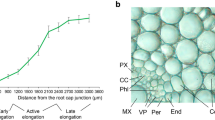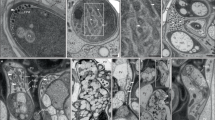Abstract
α-Expansins are extracellular proteins that increase plant cell-wall extensibility. We analysed their pattern of expression in cucumber roots in the presence and in the absence of the mycorrhizal fungus, Glomus versiforme. The distribution of α-expansins was investigated by use of two polyclonal antibodies (anti-EXPA1 and anti-EXPA2, prepared against two different cucumber α-expansins) in immunoblotting, immunofluorescence, and immunogold experiments. Immunoblot results indicate the presence of a 30-kDa band specific for mycorrhizal roots. The two antibodies identify antigens with a different distribution in mycorrhizal roots: anti-EXPA1 labels the interface zone, but the plant cell walls only weakly. By contrast, the anti-EXPA2 labels only the plant cell walls. In order to understand the potential role of α-expansins during the accommodation of the fungus inside root cells, we prepared semi-thin sections to measure the size of cortical cells and the thickness of cortical cell walls in mycorrhizal and non-mycorrhizal root. Mycorrhizal cortical cells were significantly larger than non-mycorrhizal cells and had thicker cell walls. In double-labelling experiments with cellobiohydrolase–gold complex, we observed that cellulose was co-localized with α-expansins. Taken together, the results demonstrate that α-expansins are more abundant in the cucumber cell walls upon mycorrhizal infection; we propose that these wall-loosening proteins are directly involved in the accommodation of the fungus by infected cortical cells.







Similar content being viewed by others
Abbreviations
- AM:
-
Arbuscular mycorrhiza(l)
- EXPA:
-
α-Expansin
- EXPB:
-
β-Expansin
- CBH:
-
Cellobiohydrolase
- XET:
-
Xyloglucan endotransglycosylase
References
Balestrini R, Hahn M, Faccio A, Mendgen K, Bonfante P (1996) Differential localization of carbohydrate epitopes in plant cell walls in the presence and absence of arbuscular mycorrhizal fungi. Plant Physiol 111:203–213
Balestrini R, Josè-Estanyol M, Puigdomènech P, Bonfante P (1997) Hydroxyproline-rich glycoprotein mRNA accumulation in maize root cells colonized by the arbuscular mycorrhizal fungus as revealed by in situ hybridization. Protoplasma 198:36–42
Blancaflor EB, Zhao L, Harrison MJ (2001) Microtubule organization in root cells of Medicago truncatula during development of an arbuscular mycorrhizal symbiosis with Glomus versiforme. Protoplasma 217:154–165
Bonfante P (2001) At the interface between mycorrhizal fungi and plants: the organization of cell wall, plasma membrane and cytoskeleton. In: Hock B (ed) The mycota IX fungal associations. Springer, Berlin Heidelberg New York, pp 45–61
Bonfante P, Vian B, Perotto S, Faccio A, Known JP (1990) Cellulose and pectin localization in roots of mycorrhizal Allium porrum: labelling continuity between host cell wall and interfacial material. Planta 180:537–547
Carpita NC, Gibeaut DM (1993) Structurals models of primary cell walls in flowering plants: consistency of molecular structure with the physical properties of the walls during growth. Plant J 3:1–30
Catala C, Rose JK, Bennett AB (2000) Auxin-regulated genes encoding cell wall-modifying proteins are expressed during early tomato fruit growth. Plant Physiol 122:527–534
Cho H-T, Kende H (1998) Tissue localization of expansins in deepwater rice. Plant J 15:805–812
Cho H-T, Cosgrove DJ (2000) Altered expression of expansin modulates leaf growth and pedicel abscission in Arabidopsis thaliana. Proc Natl Acad Sci USA 97:9783–9788
Cosgrove DJ (1993) Wall extensibility: its nature, measurement, and relationship to plant cell growth. New Phytol 124:1–23
Cosgrove DJ (1999) Enzymes and other agents that enhance cell wall extensibility. Annu Rev Plant Physiol Plant Mol Biol 50:391–417
Cosgrove DJ (2000) New genes and new biological roles for expansins. Curr Opin Plant Biol 3:73–78
Cosgrove DJ (2001) Wall structure and wall loosening: a look backwards and forwards. Plant Physiol 125:131–134
Cosgrove DJ, Bedinger P, Durachko DM (1997) Group I allergens of grass pollen as cell wall-loosening agents. Proc Natl Acad Sci USA 94:6559–6564
Cosgrove DJ, Li LC, Cho H-T, Hoffmann-Benning S, Moore RC, Blecker D (2002) The growing world of expansins. Plant Cell Physiol 43:1436–1444
Downes BP, Steinbaker CR, Crowell DN (2001) Expression and processing of a hormonally regulated β-expansin from soybean. Plant Physiol 126:244–252
Fry SC (1995) Polysaccharide—modifying enzymes in the plant cell wall. Annu Rev Plant Physiol Plant Mol Biol 46:497–520
Genre A, Bonfante P (2002) Epidermal cells of a symbiosis-defective mutant of Lotus japonicus show altered cytoskeleton organisation in the presence of a mycorrhizal fungus. Protoplasma 219:43–50
Giordano W, Hirsch AM (2004) The expression of MaEXP1, a Melilotus alba expansin gene, is upregulated during the sweetclover-Sinorhizobium meliloti interaction. Mol Plant-Microbe Interact 17(6):613–622
Harrison MJ (1999) Molecular and cellular aspects of the arbuscular mycorrhizal symbiosis. Annu Rev Plant Physiol Plant Mol Biol 50:361–389
Harrison EP, McQueen-Mason SJ, Manning K (2001) Expression of six expansin genes in relation to extension activity in developing strawberry fruit. J Exp Bot 52:1437–1446
Kende H, Bradford K, Brummell DA, Cho H-T, Cosgrove DJ, Fleming AJ, Gehring C, Lee Y, McQueen-Mason SJ, Rose JKC, Voesenek LACJ (2004) Nomenclature for members of the expansin superfamily of genes and proteins. Plant Mol Biol (in press)
Kistner C, Parniske M (2002) Evolution of signal transduction in intracellular symbiosis. Trends Plant Sci 7:511–518
Lee Y, Choi D, Kende H (2001) Expansins: ever-expanding numbers and functions. Curr Opin Plant Biol 4:527–532
Li ZC, Durachko DM, Cosgrove DJ (1993) An oat coleoptile wall protein that induced wall extension in vitro and that is antigenically related to a similar protein from cucumber hypocotyls. Planta 191:349–356
Li Y, Darley CP, Ongaro V, Fleming A, Schipper O, Baldauf SL, McQueen-Mason SJ (2002) Plant expansins are a complex multigene family with an ancient evolutionary origin. Plant Physiol 128:854–864
Link BM, Cosgrove DJ (1998) Acid-growth response and α-expansins in suspension cultures of bright yellow 2 tobacco. Plant Physiol 118:907–916
Liu J, Blaylock LA, Endre G, Cho J, Town CD, Vandebosh KA, Harrison MJ (2003) Transcript profiling coupled with spatial expression analyses reveals genes involved in distinct developmental stages of an arbuscular mycorrhizal symbiosis. Plant Cell 15:2106–2123
Maldonado-Mendoza IE, Harrison MJ (1998) A xyloglucan endo-transglycosylase (XET) gene from Medicago truncatula induced in arbuscular mycorrhizae. In: Abstract from 2nd International Conference on Mycorrhiza, 5–10 July 1998, Uppsala
McQueen-Mason S, Cosgrove DJ (1994) Disruption of hydrogen bonding between wall polymers by proteins that induce plant wall extension. Proc Natl Acad Sci USA 91:6574–6578
McQueen-Mason S, Durachko DM, Cosgrove DJ (1992) Two endogenous proteins that induce cell wall expansion in plants. Plant Cell 4:1425–1433
McQueen-Mason S, Fry SC, Durachko DM, Cosgrove DJ (1993) The relationship between xyloglucan endotransglycosylase and in vitro cell wall extension in cucumber hypocotyls. Planta 190:327–331
Novero M, Faccio A, Genre A, Stougaard J, Webb KJ, Mulder L, Parniske M, Bonfante P (2002) Dual requirement in the LjSym4 gene for mycorrhizal development in epidermal and cortical cells of Lotus japonicus roots. New Phytol 154:741–749
Pagant S, Bichet A, Sugimoto K, Lerouxel O, Desprez T, Mc Cann M, Lerouge P, Vernhettes S, Hofte H (2002) KOBITO1 encodes a novel plasma membrane protein necessary for normal synthesis of cellulose during cell expansion in Arabidopsis. Plant Cell 14:2001–2003
Parniske M (2000) Intracellular accomodation of microbes by plants: a common developmental program for symbiosis and disease? Curr Opin Plant Biol 3:320–328
Perotto S, Coisson JD, Perugini J, Cometti V, Bonfante P (1997) Production of pectin degrading enzymes by ericoid mycorrhizal fungi. New Phytol 135:151–162
Pien S, Wyrzykowska J, McQueen-Mason S, Smart C, Fleming A (2001) Local expression of expansin induces the entire process of leaf development and modifies leaf shape. Proc Natl Acad Sci USA 98:11812–11817
Qin L, Kudla U, Roze EH, Goverse A, Popeijus H, Nieuwland J, Overmars H, Jones JT, Schots A, Smant G, Bakker J, Helder J (2004) A nematode expansin acting on plants. Nature 427:30
Reiter WD (1998) The molecular analysis of cell wall components. Trends Plant Sci 3:27–32
Rochange SF, McQueen-Mason SJ (2000) Expression of a heterologous expansin in transgenic tomato plants. Planta 211:583–586
Rose JKC, Bennet AB (1999) Cooperative disassembly of the cellulose-xiloglucan network of plant cell walls: parallels between cell expansion and fruit ripening. Trends Plant Sci 4:176–183
Rose JKC, Cosgrove DJ, Albersheim P, Darvill AG, Bennett AB (2000) Detection of expansin proteins and activity during tomato ontogeny. Plant Physiol 123:1583
Schüßler A, Schwartzott D, Walker C (2001) A new fungal phylum, the Glomeromycota: phylogeny and evolution. Mycol Res 105(12):1413–1421
vanBuuren M, Maldonado-Mendoza IE, Trieu AT, Blaylock LA, Harrison MJ (1999) Novel genes induced during an arbuscular mycorrhizal (AM) symbiosis formed between Medicago truncatula and Glomus versiforme. Mol Plant-Microbe Interact 12:171–181
Whitney SEC, Gidley MJ, McQueen-Mason SJ (2000) Probing expansin action using cellulose/hemicellulose composites. Plant J 22:327–334
Wu Y, Sharp RE, Durachko DM, Cosgrove DJ (1996) Growth maintenance of the maize primary root at low water potentials involves increases in cell wall extensibility, expansin activity and wall susceptibility to expansins. Plant Physiol 111:765–772
Zhang N, Hasenstein KH (2000) Distribution of expansins in graviresponding maize roots. Plant Cell Physiol 41:1305—1312
Acknowledgements
This research was funded by the Italian FIRB Project (RBNE01KZE7), by IPP-CNR and CEBIOVEM (D.M. 193/2003) grants. Confocal and electron microscope facilities were available at LMA-Dipartimento di Biologia Vegetale dell’Università di Torino.
Author information
Authors and Affiliations
Corresponding author
Rights and permissions
About this article
Cite this article
Balestrini, R., Cosgrove, D.J. & Bonfante, P. Differential location of α-expansin proteins during the accommodation of root cells to an arbuscular mycorrhizal fungus. Planta 220, 889–899 (2005). https://doi.org/10.1007/s00425-004-1431-2
Received:
Accepted:
Published:
Issue Date:
DOI: https://doi.org/10.1007/s00425-004-1431-2




